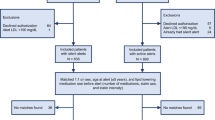Abstract
Objective:To determine the feasibility of providing cholesterol screening in the emergency department (ED) and to determine compliance with follow-up recommendations.
Design:A prospective observational study.
Setting:The Ambulatory Care and Treatment Section of the George Washington University Medical Center ED.
Patients/participants:All patients seen in the Ambulatory Care and Treatment Section of the ED who were 18 years of age or older and who were residents of the metropolitan Washington, D.C., area were eligible to paticipate. During the six-month study period, 660 patients were asked to participate and 539 (82%) agreed.
Interventions:Fingerstick cholesterol measurements were performed on all participants. Participants who had elevated cholesterol levels, as determined by the National Cholesterol Education Program guidelines, were scheduled for a six-week follow-up visit in the Lipid Research Clinic, where repeat fingerstick cholesterol measurements were performed. Those participants with elevated cholesterol levels were instructed to follow up with their primary care physicians. Compliance with follow-up was assessed by a telephone contact four months after the initial ED visit.
Measurements and main results:Of the 539 participants, 100 (19%) were found to have elevated cholesterol levels. Fifty-three (53%) returned for the six-week follow-up visit. Of the 53 who returned, 7 (13%) had normal and 46 (87%) had elevated cholesterol levels. Of the 46 participants with elevated cholesterol levels, 15 (33%) reported four months after their ED visit that they had received further follow-up care.
Conclusions:Cholesterol screening in the ED is feasible, but compliance with follow-up is less than desirable.
Similar content being viewed by others
References
The Expert Panel. Report of the National Cholesterol Education Program Expert Panel on Detection, Evaluation and Treatment of High Blood Cholesterol in Adults. Arch Intern Med. 1988;148:36–69.
State-specific changes in cholesterol screening and awareness, United States, 1987 – 1988. MMWR. 1990;39:304–14.
Chernow DI, Iserson KV, Criss E. Use of the emergency department for hypertension screening: a prospective study. Ann Emerg Med. 1987;16:180–2.
Kaazuba AL, Matenoaki G, Gibson G. Evaluation of the emergency department as a site for hypertension screening. J Am Coll Emerg Physicians. 1978;7:51–5.
Polis MS, Smith JP, Sainer D, Brennemen MN, Kaslon RA. Prospects for an emergency department-based adult immunization program. Arch Intern Med. 1987;147:1999–2001.
Hospital statistics. Chicago: American Hospital Association, 1989.
Vayda E, Gent M, Hendershot A. Emergency department use at two Hamilton hospitals. Can Med Assoc J. 1975;112:961–5.
Weinerman ER, Ratner RS, Robbins A, et al. Yale studies in ambulatory medical care: determinants of use of hospital emergency services. Am J Public Health. 1966;56:1037–56.
Studnicki J, Stevens CE. An approach to the assessment of emergency medical care utilization. MD State Med J. 1982;9:45–8.
Bradford R, Bachorik P, Roberts K, et al. Blood cholesterol screening in several environments using a portable dry chemistry analyzer and fingerstick. Am J Cardiol. 1990;65:6–13.
Gordon RL, Klag MJ, Whelton PK. Community cholesterol screening impact of labeling on participant behavior. Arch Intern Med. 1990;150:1957–60.
Ramstan L, Luepker R, Pirie P. Effect of screening and referral on follow-up and treatment of high blood cholesterol levels. Am J Prev Med. 1988;4:244–8.
Strauss JH, Orr ST, Charney E. Referrals from an emergency room to primary care practices at an urban hospital. Am J Public Health. 1983;73:57–61.
Velez R, Anderson L, McFall MA, Magruder-Habib K. Improving patient follow-up in incidental screening through referral letters. Arch Intern Med. 1985;145:2184–7.
Block G, Clifford C, Naughton MD, Henderson M, McAdams M. A brief dietary screen for high fat intake. J Nutr Educ 1989;21:199–207.
Author information
Authors and Affiliations
Additional information
Received from the George Washington University Medical Center, Washington, DC, and the Section of General Internal Medicine, Boston University School of Medicine, Boston, Massachusetts.
Rights and permissions
About this article
Cite this article
Burns, R.B., Stoy, D.B., Feied, C.F. et al. Cholesterol screening in the emergency department. J Gen Intern Med 6, 210–215 (1991). https://doi.org/10.1007/BF02598962
Issue Date:
DOI: https://doi.org/10.1007/BF02598962



